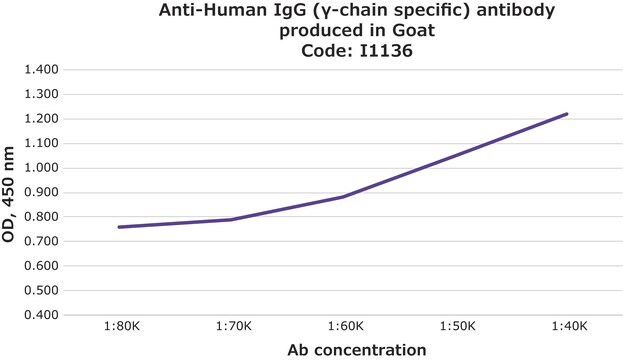P8047
Anti-Human IgG (γ-chain specific), F(ab′)2 fragment−R-Phycoerythrin antibody produced in goat
affinity isolated antibody, buffered aqueous solution
Sign Into View Organizational & Contract Pricing
All Photos(1)
About This Item
Recommended Products
biological source
goat
Quality Level
conjugate
phycoerythrin (R-PE) conjugate
antibody form
affinity isolated antibody
antibody product type
secondary antibodies
clone
polyclonal
form
buffered aqueous solution
technique(s)
direct immunofluorescence: 1:32
shipped in
wet ice
storage temp.
2-8°C
target post-translational modification
unmodified
Related Categories
General description
IgG is a glycoprotein antibody that contains two equivalent light chains and a pair of identical heavy chains. IgGs have four distinct isoforms, ranging from IgG1 to IgG4.
Immunogen
Purified human IgG
Application
Anti-Human IgG (γ-chain specific), F(ab′)2 fragment R-Phycoerythrin antibody produced in goat has been used in bead-based assay and immunoassay multiplex magpix
Anti-Human IgG (γ-chain specific), F(ab′)2 fragment-R-Phycoerythrin antibody is suitable for use in flow cytometry . The antibody can also be used for direct immunofluorescence (1:32).
Biochem/physiol Actions
Digestion of IgG by papain results in generation of fragment antigen binding (Fab) comprising of one complete L chain and a variable and CH1 region of H chain. Pepsin digestion of IgG results in fragment crystallisable (fc), comprises the H chain constant region.
IgG antibodies regulate immunological responses to allergy and pathogenic infections. IgGs have also been implicated in complement fixation and autoimmune disorders . The use of anti-human IgG (γ-chain specific), F(ab′)2 fragment-R-Phycoerythrin antibody helps avoid background staining due to the presence of Fc receptors. The product is specific for human IgG when tested against purified human IgA, IgG, IgM, Bence Jones κ, and Bence Jones λ myeloma proteins.
Physical form
Solution in 0.01 M phosphate buffered saline, pH 7.4, containing 0.1 mM EDTA, 1 mM iodoacetamide, 1% bovine serum albumin and 15 mM sodium azide
Disclaimer
Unless otherwise stated in our catalog or other company documentation accompanying the product(s), our products are intended for research use only and are not to be used for any other purpose, which includes but is not limited to, unauthorized commercial uses, in vitro diagnostic uses, ex vivo or in vivo therapeutic uses or any type of consumption or application to humans or animals.
Not finding the right product?
Try our Product Selector Tool.
Storage Class Code
12 - Non Combustible Liquids
WGK
WGK 1
Flash Point(F)
Not applicable
Flash Point(C)
Not applicable
Personal Protective Equipment
dust mask type N95 (US), Eyeshields, Gloves
Certificates of Analysis (COA)
Search for Certificates of Analysis (COA) by entering the products Lot/Batch Number. Lot and Batch Numbers can be found on a product’s label following the words ‘Lot’ or ‘Batch’.
Already Own This Product?
Find documentation for the products that you have recently purchased in the Document Library.
Bartholomew N Ondigo et al.
PeerJ, 7, e6120-e6120 (2019-01-11)
New reagents have emerged allowing researchers to assess a growing number of vaccine-associated immune parameters. Multiplex immunoassay(s) are emerging as efficient high-throughput assays in malaria serology. Currently, commercial vendors market several bead reagents for cytometric bead assays (CBA) but relative
Anne E P Frosch et al.
The American journal of clinical nutrition, 100(3), 968-973 (2014-08-01)
Achieving optimal iron status in children in malaria-endemic areas may increase the risk of malaria. Malaria itself may contribute to iron deficiency, but the impact of an interruption in malaria transmission on the prevalence of iron deficiency is unknown. We
Bartholomew N Ondigo et al.
The Journal of infectious diseases, 210(7), 1123-1132 (2014-04-17)
Tools that estimate recent and long-term malaria transmission in a population would be highly useful for malaria elimination programs. The prevalence of antibodies to 11 Plasmodium falciparum antigens was assessed by cytometric bead assay or enzyme-linked immunosorbent assay in 1000
William Spooner et al.
Nature communications, 9(1), 4128-4128 (2018-10-10)
Selecting the most appropriate protein sequences is critical for precision drug design. Here we describe Haplosaurus, a bioinformatic tool for computation of protein haplotypes. Haplosaurus computes protein haplotypes from pre-existing chromosomally-phased genomic variation data. Integration into the Ensembl resource provides
Optimization of a magnetic bead-based assay MAGPIX textregistered-Luminex) for immune surveillance of exposure to malaria using multiple Plasmodium antigens and sera from different endemic settings
Varela ML, et al.
Malaria Journal, 17(1), 324-324 (2018)
Our team of scientists has experience in all areas of research including Life Science, Material Science, Chemical Synthesis, Chromatography, Analytical and many others.
Contact Technical Service






